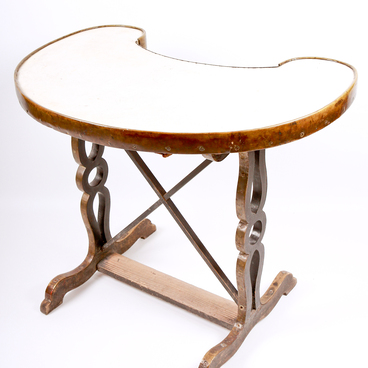The Kasimov Museum-Reserve has a collection of trunks of different sizes. There is also a travel trunk which was taken on trips.
The chest is 67 centimeters high, it is made of wood and upholstered inside with fabric. It has wrought iron handles on the sides which were used to move the trunk to the house, into a cart or a train. An iron closing mechanism which was locked with a key is in the middle of the case. To make the case strong, it was bound with iron strips with rivets.
In Rus, the trunk had several functions. The travel trunk was a predecessor of a modern suitcase, but the chests in huts were more like multifunctional pieces of furniture. They were used as tables, beds, benches, wardrobes or chest of drawers — people usually kept their clothes, houseware, letters and books in them.
There was a special kind of a small trunk used for money and jewelries — it was called ‘podgolovnik’ (‘under head’). At night, owner of the trunk put it under the pillow so that nobody could steal valuables while sleeping.
Trunks for noble families were made of valuable species of wood: oak, ash or cedar. Some of them were decorated with paintings: images of plants, flowers, genre scenes, depicted heroes, animals and birds.
Paintings, decoration and a number of trunks at home could tell how wealthy the family was. They also were a significant part of the dowry, which bride’s parents gave to their son-in-law’s family. Tablecloths, blankets, bed linen and other items that could be useful for the bride were put inside.
In Russia, Makaryev’s trunks were rather popular. They were made by craftsmen from the Makaryev District of the Nizhny Novgorod Governorate. They began to be produced in the late 17th century. Visiting local fairs, merchants bought the trunks to transport their valuable things — jewelry, furs and lace. After that, Makaryev’s trunks started to be actively used in other regions of Russia and even abroad: they could be found in cities of Khiva and Bukhara in the Central Asia.
The chest is 67 centimeters high, it is made of wood and upholstered inside with fabric. It has wrought iron handles on the sides which were used to move the trunk to the house, into a cart or a train. An iron closing mechanism which was locked with a key is in the middle of the case. To make the case strong, it was bound with iron strips with rivets.
In Rus, the trunk had several functions. The travel trunk was a predecessor of a modern suitcase, but the chests in huts were more like multifunctional pieces of furniture. They were used as tables, beds, benches, wardrobes or chest of drawers — people usually kept their clothes, houseware, letters and books in them.
There was a special kind of a small trunk used for money and jewelries — it was called ‘podgolovnik’ (‘under head’). At night, owner of the trunk put it under the pillow so that nobody could steal valuables while sleeping.
Trunks for noble families were made of valuable species of wood: oak, ash or cedar. Some of them were decorated with paintings: images of plants, flowers, genre scenes, depicted heroes, animals and birds.
Paintings, decoration and a number of trunks at home could tell how wealthy the family was. They also were a significant part of the dowry, which bride’s parents gave to their son-in-law’s family. Tablecloths, blankets, bed linen and other items that could be useful for the bride were put inside.
In Russia, Makaryev’s trunks were rather popular. They were made by craftsmen from the Makaryev District of the Nizhny Novgorod Governorate. They began to be produced in the late 17th century. Visiting local fairs, merchants bought the trunks to transport their valuable things — jewelry, furs and lace. After that, Makaryev’s trunks started to be actively used in other regions of Russia and even abroad: they could be found in cities of Khiva and Bukhara in the Central Asia.

